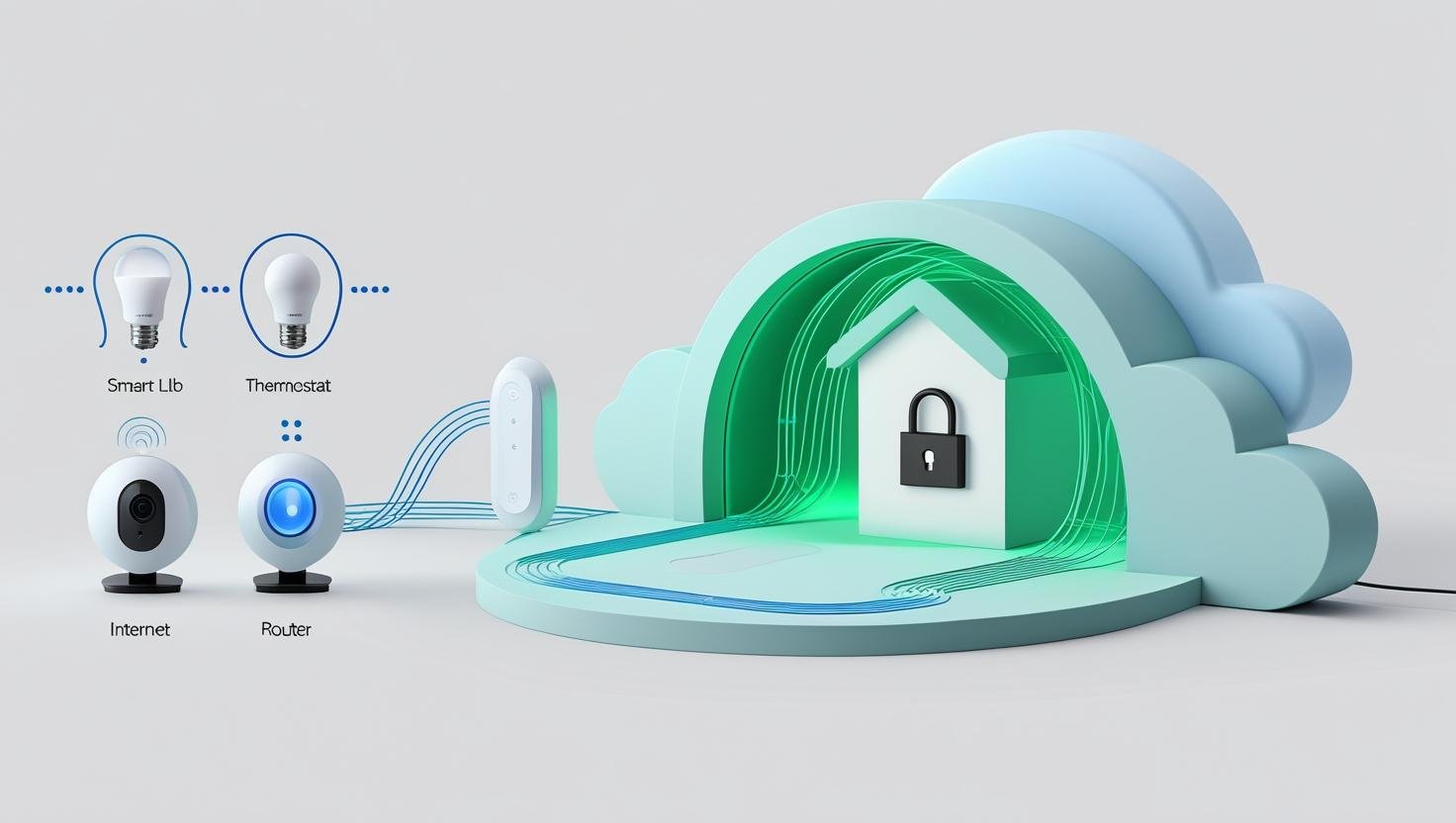Your smart home is designed for convenience, from voice-controlled lighting to automated thermostats and security cameras. Yet, with every connected device, you introduce a potential entry point for cyber threats. While individual devices often have basic security, the overall vulnerability of your network can be a significant concern. This article dives into why a Virtual Private Network (VPN) isn’t just for your laptop or phone—it’s a critical tool for fortifying your entire smart home, shielding every connected gadget from prying eyes and potential attacks. Discover how a VPN can elevate your smart home’s defense, ensuring your privacy and peace of mind.

The Unseen Risks of Your Connected Home
Smart homes bring comfort, but also introduce new security challenges that many users overlook:
- Vulnerable IoT Devices: Many smart devices (Internet of Things) are not built with robust security. Default passwords, unpatched firmware, and lack of encryption can make them easy targets for hackers.
- Data Collection by Manufacturers: Your smart devices collect vast amounts of data about your habits, movements, and even conversations. This data is often sent back to manufacturers and third parties, raising privacy concerns.
- DDoS Attacks and Botnets: Compromised smart devices can be recruited into botnets for Distributed Denial of Service (DDoS) attacks, consuming your bandwidth or even making your devices unresponsive.
- Eavesdropping and Surveillance: Smart speakers and cameras, if compromised, can be used to listen in on your private conversations or watch your home without your knowledge.
- Geo-Restrictions on Smart Services: Some smart services or content accessible through smart devices might be geo-restricted, limiting their functionality based on your location.
How a VPN Secures Your Entire Smart Home Network
Unlike installing a VPN on individual devices, setting up a VPN on your router offers a comprehensive solution for your smart home. Here’s how it works:
- Encrypts All Traffic: Once configured on your router, the VPN encrypts all data flowing in and out of your home network. This means every smart device—from your smart fridge to your doorbell camera—benefits from the encryption, even if it doesn’t support VPN software directly.
- Masks Your IP Address: Your entire smart home network will appear to be in the location of your chosen VPN server. This hides your real IP address from manufacturers, potential attackers, and third-party data collectors, significantly enhancing your privacy.
- Bypasses Geo-Restrictions for IoT: Access smart home features or streaming content on devices (like smart TVs or media players) that might be regionally locked. By changing your virtual location, you unlock global functionalities.
- Protects Against DDoS Attacks: By masking your real IP address, a VPN makes it much harder for malicious actors to launch DDoS attacks against your smart home devices or entire network.
- Consistent Protection: A router-level VPN provides always-on protection without needing to install individual VPN apps on each smart device, many of which don’t support them.
Essential VPN Features for Smart Home Security
Choosing the right VPN for your smart home means looking beyond typical features. Focus on these specifics for router compatibility and robust IoT protection:
1. Router Compatibility & Firmware Support
The most crucial feature. Your chosen VPN must offer clear instructions and support for installation on your specific router model or be compatible with custom firmware like DD-WRT or OpenWRT. Some VPNs even offer pre-configured routers.
2. Unbreakable Encryption (AES-256) and Robust Protocols
Ensure military-grade AES-256 encryption. For protocols, OpenVPN is widely supported on routers, offering strong security. Newer, faster protocols like WireGuard are ideal if your router supports them, ensuring speed without compromising security.
3. Strict No-Logs Policy
A non-negotiable for privacy. The VPN provider must have a verified no-logs policy, meaning they don’t record your online activities or connection data, ensuring your smart home’s data remains private.
4. Kill Switch Functionality
A Kill Switch automatically blocks all internet traffic if the VPN connection drops, preventing any of your smart devices from accidentally exposing your real IP address or unencrypted data.
5. Large Global Server Network
A broad selection of servers ensures you can find fast, reliable connections and effectively bypass geo-restrictions for any region-locked smart services or content.
6. High Speeds and Unlimited Bandwidth
Smart homes require stable connections for optimal performance. High-speed servers and unlimited bandwidth are essential to avoid lag or buffering, especially if you have smart cameras or media streaming devices.
Recommended VPNs for Smart Home Protection
When it comes to securing your entire smart home network via your router, these VPNs stand out for their router compatibility, strong security, and reliable performance:
- ExpressVPN: Known for its extensive router support (including dedicated firmware for some models) and excellent speeds. Its ease of setup on routers makes it a top choice for comprehensive home protection.
- NordVPN: Offers good router compatibility and boasts the fast NordLynx protocol. It’s a solid choice for securing all devices, with strong security features to protect against smart home vulnerabilities.
- Surfshark: An affordable option with excellent router support and unlimited simultaneous connections. This means you can protect every single device in your smart home without worrying about device limits.
- Proton VPN: A privacy-focused VPN with strong encryption and a transparent no-logs policy, making it a reliable choice for securing sensitive smart home data. While router setup may be more manual, its security benefits are significant.
- CyberGhost: User-friendly even for router setups, with a large server network and optimized servers that can handle the demands of a connected home while maintaining privacy.
Setting Up a VPN on Your Home Router for Smart Home Security
Installing a VPN directly on your router is the most effective way to protect all your smart home devices. The process can vary slightly depending on your router model and VPN provider, but here are the general steps:
- Check Router Compatibility: First, confirm if your current router supports VPN client software. Many modern routers, especially those from brands like Asus, Netgear, or Linksys, do. If not, you might need to flash custom firmware (like DD-WRT or OpenWRT) or purchase a pre-configured VPN router.
- Choose and Subscribe to a VPN Service: Select a reputable VPN provider that offers robust router support and provides clear setup guides (refer to our recommendations above).
- Access Your Router’s Admin Panel: Open a web browser, type your router’s IP address (often 192.168.1.1 or 192.168.0.1) into the address bar, and log in with your router’s admin credentials.
- Configure the VPN Settings: Navigate to the VPN client section in your router’s settings. You’ll typically need to input your VPN provider’s server addresses, your username, and password, and select the VPN protocol (e.g., OpenVPN). Your VPN provider will supply these details.
- Save Settings and Reboot: After entering all the necessary information, save your settings and reboot your router.
- Verify the Connection: Once your router restarts, all devices connected to its network will now be routing their traffic through the VPN. You can verify this by checking the IP address of any smart device (if it has a browser) or connecting your computer to the network and using a “What’s my IP” tool.
Conclusion: The Smart Choice for a Secure Smart Home
As our homes become increasingly connected, proactive security measures are no longer optional. Integrating a VPN at the router level is a powerful and efficient way to encrypt all your smart home devices, mask your IP address, and protect your privacy from cyber threats. By making this smart security choice, you can truly enjoy the convenience of your connected home with the confidence that your data and devices are fortified against the evolving digital landscape.
For a foundational understanding of VPN necessity, consult our guide: What is a VPN and Why You Need One.
Published on: July 17, 2025

